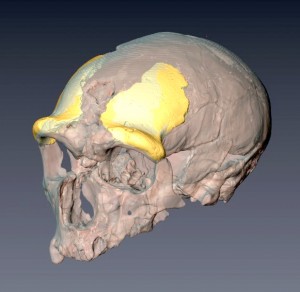First Neandertal From Netherlands
Posted by: Loren Coleman on June 15th, 2009

For the first time ever, a fossil of a Neanderthal has been discovered in the Netherlands. The skull fragment, over 40,000 years old, with its characteristically thick Neanderthal eyebrow ridge, was found off the coast of Zeeland, dredged up from the bottom of the North Sea. Huge quantities of fossil bones have been brought to the surface from this seabed since 1874, however, this is the first time a Neanderthal fossil has been found. The unique discovery was officially unveiled on the 15th of June by Ronald Plasterk (Dutch Minister of Education, Culture and Science) at the Rijksmuseum van Oudheden (National Museum of Antiquities) in Leiden, where it is on display to the public starting from June 16th [2009].

[Found in 2001, but only first displayed now, in 2009.]
More.
About Loren Coleman
Loren Coleman is one of the world’s leading cryptozoologists, some say “the” leading living cryptozoologist. Certainly, he is acknowledged as the current living American researcher and writer who has most popularized cryptozoology in the late 20th and early 21st centuries.
Starting his fieldwork and investigations in 1960, after traveling and trekking extensively in pursuit of cryptozoological mysteries, Coleman began writing to share his experiences in 1969. An honorary member of Ivan T. Sanderson’s Society for the Investigation of the Unexplained in the 1970s, Coleman has been bestowed with similar honorary memberships of the North Idaho College Cryptozoology Club in 1983, and in subsequent years, that of the British Columbia Scientific Cryptozoology Club, CryptoSafari International, and other international organizations. He was also a Life Member and Benefactor of the International Society of Cryptozoology (now-defunct).
Loren Coleman’s daily blog, as a member of the Cryptomundo Team, served as an ongoing avenue of communication for the ever-growing body of cryptozoo news from 2005 through 2013. He returned as an infrequent contributor beginning Halloween week of 2015.
Coleman is the founder in 2003, and current director of the International Cryptozoology Museum in Portland, Maine.










Good news, Loren!!!
Very interesting!
Now read about the “Mediterranian” Missing Link.
new contestant in the “Out of Africa” debate.
How did they arrive at the “over 40,000 years” estimate?
As for Anoiapithecus, the split with chimpanzees (at least) was much more recent, “probably less than 5.4 million years ago,” mentions Science Daily.
Coming on the heels of last years spectacular find of paleolithic stone hand axes, it’s pretty interesting. There is currently a major effort in countries that border the North Sea to more thoroughly map its landscape, known as “the Doggerlands” with an eye towards finding archaeological sites of the late pleistocene and early holocene.
Here’s the Wikipedia link from whence those interested can find more info.
As an aside, last weeks New York Times featured an article on the artist Viktor Deak, and the work he’s done supporting the upcoming exhibit on human origins at the AMNH in NYC. His website has some particularly interesting interpretations in both 2D paintings and drawings as well as 3D sculpture of our ancestors. And when I say “interesting” is should clarify that to mean “beautiful and spectacularly lifelike”.
I hate to say this, but I don’t see what the big deal is. Neanderthals were already known to be in Europe at this time, and there’s nothing special about the modern-day borders of the Netherlands to keep them out. In fact, I suspect there are many Neanderthal fossils at the bottom of the English Channel, which was dry land during the ice ages.
Fhqwhgads,
Neandertal fossils of any kind are so rare that every new find is a big deal.